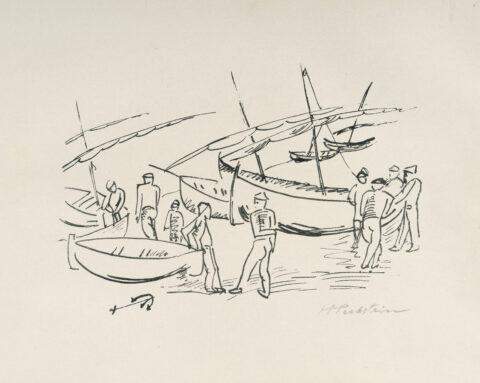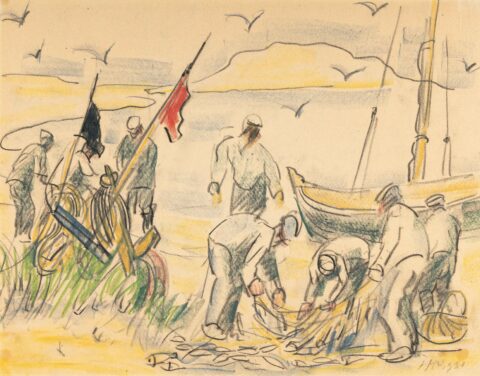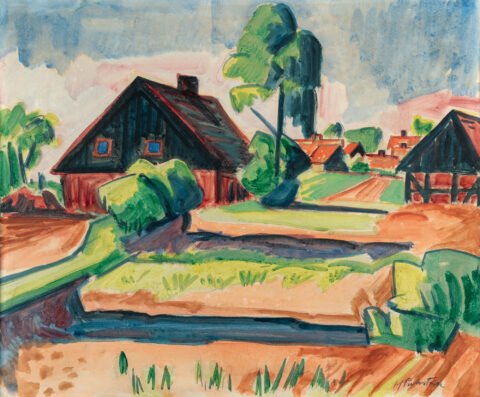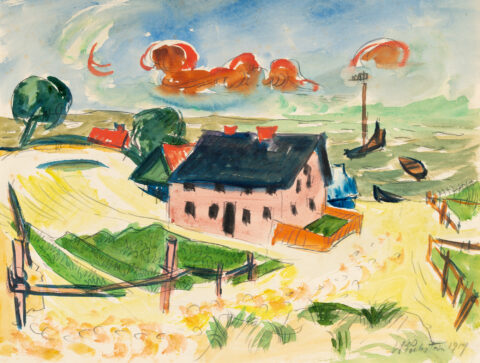
The dance (Figures dancing and bathing by a forest pool)
Details
From the “7. Jahresmappe der Künstlergruppe Brücke: Max Pechstein”. Krüger L 149; Söhn HDO 217-3. Literature: Jähner, Horst, Max Pechstein, in: Malerei des deutschen Expressionismus, Edition Cantz, Stuttgart 1987, p. 175, with ill. Exhibitions: Graphik des deutschen Expressionismus, Künstlerhaus, Vienna et. al. 1984-1989, cat. no.5; Graphik des deutschen Expressionismus, Neuer Sächsischer Kunstverein, Dresden 1991-1993, cat. no.149; Neue Galerie Museum of Art, New York 2009/10; Galerie St. Etienne, New York 2011/12.Provenance:collection of Dr. Wilhelm F. Arntz (1903-1985), Haag/Upper Bavaria; collection of/estate of Serge Sabarsky, New York, acquired from the aforementioned in 1984;collection of/Foundation Vally Sabarsky, New York.
Descrizione
• A motif from the time Pechstein spent with his artist friends from the Brücke group at the Moritzburg ponds
• Inspired by the famous work “La Danse” by Henri Matisse
• Dance was an important recurring motif in Pechstein’s oeuvre
The turn of the century turned out to be a great time of departure. The burgeoning cities were adorned with huge residential buildings and imposing town halls. Industrialisation meant that enormous resources were becoming available. While some mounted their cars and began to rely on the increasing mechanisation of the world – others cried “Back to nature!”. It was during this time that the Brücke group was founded. In their works we see a different empire, a modern, liberated society with a focus on humans and nature – characterised by an unconventional style. In 1909/10, Max Pechstein spent the summers at the Moritzburg ponds together with his fellow artists Heckel and Kirchner, painting in the open air. They brought the models, including the famous “Fränzi”, with them from Dresden. The bathing scenes, which Pechstein draws on in this later lithograph, were created during this artistically fruitful time. Henri Matisse created the first version of “La Danse” in 1909. The work, which displays a similar motif, is now exhibited in the Museum of Modern Art in New York. It is conceivable that Pechstein knew of the image through a reproduction and was inspired by it. The dancing and bathing nudes are shown engaged in a loose dance, staged in a variety of postures and sweeping movements on and in the water. What is significant in this work is the flat manner in which it is depicted and the reduced, abstract forms.
* Tutte le informazioni includono la commissione a carico dell'acquirente (27%) senza IVA e senza garanzia. Salvo errori.
** Tutte le informazioni più la commissione a carico dell'acquirente e l'IVA e senza garanzia. Salvo errori.
*** Con riserva: L'offerta è stata accettata al di sotto del limite. L'acquisizione dell'opera potrebbe essere ancora possibile nella nostra vendita post-asta.
R = Le opere d'arte regolarmente tassate
N = Opere d'arte soggette a tassazione differenziata e provenienti da un paese non UE
Non è consentita la riproduzione e la distribuzione privata o commerciale di tutte le illustrazioni delle opere esposte nell'archivio della mostra e dell'asta. Tutti i diritti riservati.







